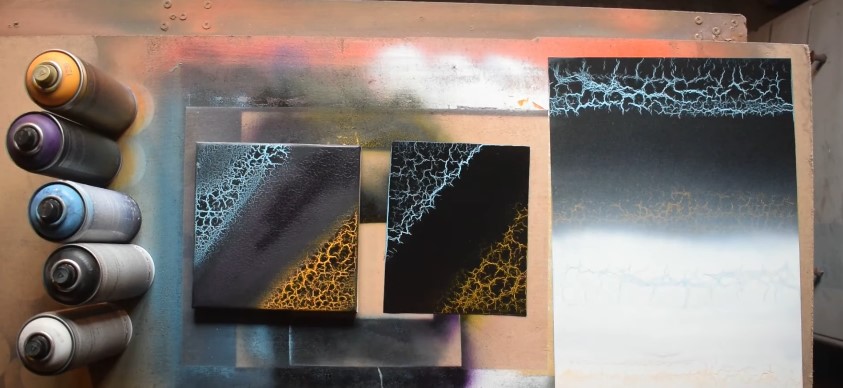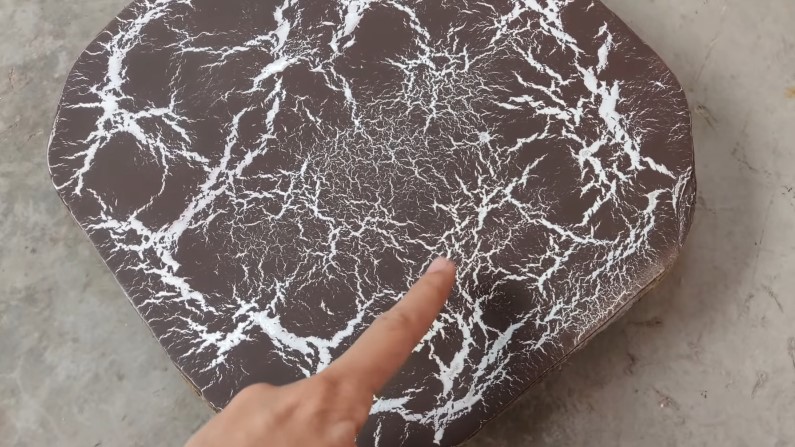Are you one of the many people who have noticed that your spray paint sometimes cracks? It may not often be a big deal, but it can be frustrating when you’ve spent hours painting a wall and then find that the paint has chipped off in big chunks.
So why does spray paint crackle? The main reason why this happens is the paint reaction. In simple words, it’s when the second coat of paint is applied while the first coat is still tacky. When these two coats touch, they interact as they dry, causing the top coat to contract, wrinkle and crack.
Let’s get to know more about this problem, how to fix it, and a few handy tips on how to prevent it in the future.
Contents
Why Does Spray Paint Crackle?
As we mentioned, the main reason why your paint cracks is because of the reaction that takes place when two coats touch while they’re both still wet. But this can result from several other reasons. Such as:
Temperature
Temperature is the number one cause of paint reaction. If it’s too cold outside, the paint will take longer to dry. This gives the two coats more time to interact and react with each other, which then causes the paint to crack.
On the other hand, when it’s too hot and humid, the paint’s solvent evaporates much faster than it should. This makes the paint dry before it has had a chance to properly adhere to the surface, which can also cause cracking.
Ideally, you’ll want your surrounding area to be within 10-32°C when spray painting.
Moisture and Humidity
Another reason your paint might be cracking is because of the moisture and humidity in the air. If there’s too much moisture, it can make your to-be-painted object sweat. This can prevent the paint from properly sticking to the surface and cause it to crack.
Thick Layering
Applying too thick a layer of paint in one go can also cause the paint to crack. This is because the paint dries from the outside in. So, if the layer of paint is too thick, the outside will dry before the inside has had a chance to, causing it to contract and crack.
Surface Imperfections
If the surface you’re painting is not smooth, that can also cause the paint to crack. This is because the paint will have a harder time adhering to an uneven surface, and is more likely to crack.
Not Using Primer
A lack of primers before painting could also be the reason, why your paint is cracking. Primer helps to create a smooth surface for the paint to adhere to and also provides a barrier between the paint and the surface. When you skip using a primer, especially on uneven surfaces, it can cause the paint to crack.
Read Also: Paint Not Sticking To Primer
How to Fix Spray Paint Crackle?
Now that we know why paint cracks, let’s take a look at how you can fix your cracked paint job on various surfaces. Here, we’ll show you how to fix it on walls, wood, metal, plastic, and glass.
Fix Spray Paint Cracking on Walls
The best way to fix cracked paint on walls is to sand the area down and repaint it. For the sanding, you’ll need to use sandpaper with 40-60 grit. Follow these steps.
- Start by sanding around the perimeter of the cracked area to create a smooth, consistent line.
- Then, work your way inwards until the entire area is sanded.
- Once you’re done sanding, wipe the area down with a clean cloth to remove any dust. Let the area dry completely.
- Now, you’re ready to re-paint the area. Start by painting around the perimeter of the repaired area. Then, fill in the rest of the area.
- Let the paint dry completely before moving on with further coats.
Now, if the crack was large, you’ll need to patch it up with spackle or joint compound. To do this, simply apply the compound to the crack with a putty knife and let it dry before sanding and re-painting.
Fix Spray Paint Crackling on Wood
To fix cracked paint on wood, you’ll need to remove the old paint first. The best way to do this is by using a paint stripper.
- Apply the stripper to the wood according to the instructions on the can.
- Once the paint is stripped, sand the area down with fine-grit sandpaper.
- Wipe the area down with a damp cloth to remove any dust.
- Now start painting around the perimeter of the area before filling the rest.
- Apply the second coat only after the paint has dried completely.
Fix Spray Paint Crackling on Metal
Fixing cracked paint on metal is similar to fixing it on wood. You’ll need to remove the old paint first before you can repaint the area. For this purpose, you should use an industrial paint stripper designed for use on metal. Follow the same technique as above to remove the paint and prep the surface for painting.
Fix Crackling Paint on Plastic
Fixing spray paint cracking involves cleaning up the oil bits, sanding, and adding a primer to the plastic before painting it. Here’s how to do it.
- Start by cleaning the plastic with a degreaser, preferably WD-40.
- Sand the area with a fine-grit sandpaper.
- Before priming, wipe the area clean with a damp cloth to remove any dust.
- Apply a thin layer of primer to the area and let it dry. Once the primer is dry, you can paint the plastic.
- Starting from the perimeter, paint the area in a circular motion.
Fix Crackling Paint on Glass
You can follow the same procedure of removing the cracked paint and sanding the area when fixing spray paint cracking on glass. Just use a paint remover, a sanding block, and a lint-free cloth for preparing your piece before priming and re-painting.
How to Prevent Spray Paint from Cracking?
Prevention is always the best cure. So, to prevent your paint from cracking and always get a polished finish, make sure to follow these tips.
Clean the Surface
Before you start painting, make sure to clean the surface thoroughly. This will remove any dirt, dust, or grease that could cause the paint to crack.
Check the Temperature
The temperature can affect how well the paint adheres to the surface. So, make sure to check the temperature and humidity levels before starting your project. Spray painting is best done when the surrounding area is within 10–32°C.
Use a Primer
As we’ve seen, one of the main reasons why paint cracks is because it doesn’t have a good foundation. A primer provides that foundation and also helps the paint to adhere better to the surface.
Avoid Over-Sanding
When you sand the surface before painting, you create tiny holes in it. These holes can cause the paint to crack when you apply it. So, make sure to sand lightly and evenly.
Use the Right Type of Paint
Different surfaces require different kinds of paint. Make sure to use the right type of paint for your project to avoid any issues.
Use Thinner Coats
Applying too much paint at once is one of the main causes of paint cracking. So, make sure to apply thin coats of paint and let each coat dry completely before adding the next one.
Let the Paint Dry Well
Allow the paint to dry completely before adding a new coat or before using the item. If you don’t let the paint dry properly, the coats will interact, which is the main reason behind crackling.
Use a Top Coat
A top coat helps to protect the paint and also gives it a polished finish. So, make sure to use a top coat after you’re done painting.
How Can You Intentionally Make Spray Paint Crackle Effect?
Spray paint crackling isn’t something everyone dislikes. In fact, some people love the artistic crackle effect it gives their projects. If you’re one of those people, here’s how you can achieve the look intentionally.
Step 1: Prepare Your Artwork
First thing first, create the artwork you want to paint on. This can be anything from a canvas to a piece of wood or metal. When clean and ready, add a few layers of spray paint to it.
Step 2: Apply a Layer of Craft Glue
Once your artwork is ready, use a toothpick to apply a layer of glue all over it. You can use any type of craft glue, but we recommend using Elmer’s Glue for the best results. The toothpick will make the surface uneven, preparing it for cracking.
Step 3: Atomizer More Paint from Distance
Now, hold the can of spray paint at least 7-8 inches away from your artwork and spray evenly. Make sure to apply a thin layer of paint so that it doesn’t drip.
Step 4: Let It Dry Completely
Let your artwork dry completely before waiting 10-15 minutes and painting some more. Wait for an hour or two after the last layer.
Step 5: Shred the Excess Glue
Once dry, you can carefully peel off the excess glue around the artwork with a sharp blade or knife. Be careful not to harm the top coat of paint.
Now just sit back and wait for a day or two for the layers to shrink and crack beautifully. The process may seem tedious and invisible at first, but the results are definitely worth it.
Conclusion
When spraying paint cracks, it’s not just an aesthetic issue. The cracking weakens the quality of your finish and might even compromise the structural integrity of your design. So, it’s important to know how to fix it properly.
As you’ve noticed, in most cases, you can fix cracked paint by removing the old paint and priming the surface before repainting it. Just make sure to use the right type of primer and paint for your project.
Hopefully, you now have gained a better understanding of why spray paint crackles and what you can do about it. So, go ahead and apply these tips the next time you create something.





